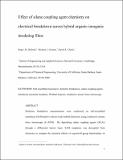Effect of Silane Coupling Agent Chemistry on Electrical Breakdown across Hybrid Organic–Inorganic Insulating Films
Citation
Diebold, Roger Mitchell, Michael J. Gordon, and David R. Clarke. 2014. “Effect of Silane Coupling Agent Chemistry on Electrical Breakdown across Hybrid Organic–Inorganic Insulating Films.” ACS Applied Materials and Interfaces 6 (15) (July 22): 11932-11939. doi:10.1021/am504305k. http://dx.doi.org/10.1021/am504305k.Abstract
Dielectric breakdown measurements were conducted on self-assembled monolayer (SAM)/native silicon oxide hybrid dielectrics using conductive atomic force microscopy (C-AFM). By depositing silane coupling agents (SCAs) through a diffusional barrier layer, SAM roughness was decoupled from chemistry to compare the chemical effects of exposed R-group functionality on dielectric breakdown. Using Weibull and current–voltage (I–V) analysis, the breakdown strength was observed to be independent of SCA R-group length, and the addition of a SAM was seen to improve the breakdown strength relative to native silicon oxide by up to 158%. Fluorinated SCAs were observed to suppress tunneling leakage and exhibited increased breakdown strength relative to their hydrocarbon analogs. Electron trapping, scattering, or attachment processes inherent to the fluorinated moieties are thought to be the origin of the improved breakdown properties.Other Sources
http://www.ncbi.nlm.nih.gov/pubmed/25010384Terms of Use
This article is made available under the terms and conditions applicable to Other Posted Material, as set forth at http://nrs.harvard.edu/urn-3:HUL.InstRepos:dash.current.terms-of-use#LAACitable link to this page
http://nrs.harvard.edu/urn-3:HUL.InstRepos:12718791
Collections
- FAS Scholarly Articles [18292]
Contact administrator regarding this item (to report mistakes or request changes)



